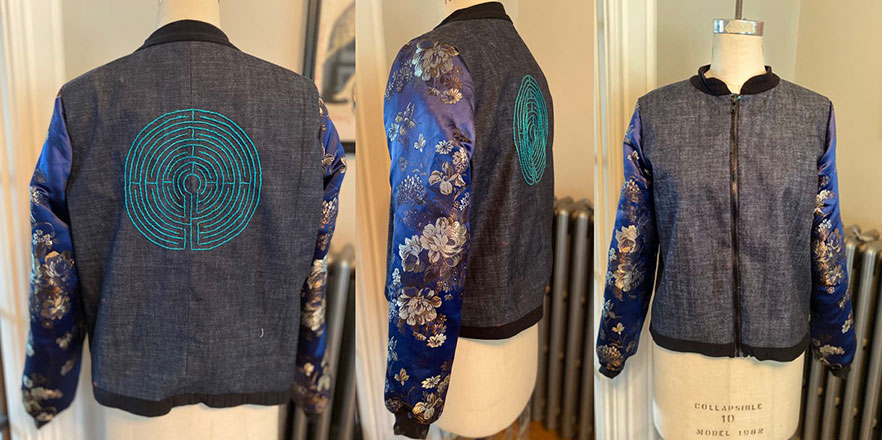Bomber Jacket Serves as Memento, Final Project for Costuming Class
By Savannah Tranchell

Whenever Annaliese Baker teaches costume construction in the Whitman College theater department, she rents a van and takes the whole class to JoAnn Fabric, where the students get to pick out material for their final project.
But this spring, Baker was faced with the challenge of moving the entire course online over spring break in response to the COVID-19 pandemic. Not only would she need to teach her students the techniques needed, she wouldn’t be able to go with them to select material for their final project.
“The problem was here we are teaching costume construction, and I have students that are both with and without equipment and supplies, so how do I do get those to them, and teach in that format,” said Baker, a visiting associate professor and director of the costume shop.
She decided to simplify. Baker spent spring break designing a piece that would cover the skills she wanted her students to learn, was not gender specific and would serve as a sort of memento for the semester.
“I felt like the project needed to be that sort of marker in time, that would be a memory of this moment of change for all of us,” Baker said.
She decided that rather than having each student create a unique final piece, she would have them all create a Sukajan bomber jacket. She created the pattern and provided each student with the necessary materials, and a little history.
Bomber jackets are known as part of a servicemember’s uniform. At some point, people began having patches or symbols sewn onto their jackets to show where they had been. An article in Vogue in 2016 chronicled the history, noting how the style grew to become a symbol of rebellion and eventually the fashion staple we know today.
Navigating Online Sewing Lessons
Cindy Abrams ’20, a politics-environmental studies major from Portland, Oregon, enrolled in the costuming class this spring to learn how to sew. Abrams hadn’t participated in the theater department before, and said it was interesting to see how the costume shop worked and be able to have access to the sewing machines there.
When Whitman College moved courses online in March, Abrams went home to Portland, where she didn’t have a sewing machine.
But Baker was able to use unspent funds from the department’s budget to purchase a machine for Abrams and have it sent to her home. Other students staying in Walla Walla were able to borrow machines from the costume shop.
“It was a nice feeling know I could actually start to make something. I really enjoyed learning to use a sewing machine,” Abrams said.
The class is a mix of skills, with some like Abrams who had never sewn before, and a few who are taking the course for the second time to polish their skills. Baker offered video office hours where students could log-on and talk through their sewing challenges and she could watch their progress. She also posted YouTube videos demonstrating the techniques.
“It’s so hard when you’re talking about sewing — explaining what their problem is, and using the correct term, becomes problematic,” Baker said. But she uses her previous experience teaching online at other institutions to her advantage, breaking down each step into manageable pieces. “It’s all so very odd. We’re all just trying to do our best work in the best way.”
It’s been a challenge, Abrams said, and she missed being able to work in the costume shop and ask either Baker or costume shop assistant Eliza Van De Rostyne for help.
“Normally, when you’re in the costume shop, there’s always at least one person in there, and I ask for help every 15 minutes,” Abrams said. But she still enjoyed learning how to embroider, and is continuing to work on her final jacket.
For the class, Baker had each student hand-embroider a labyrinth pattern on the back.
“It’s pretty easy for someone to pick up the symbolism of the labyrinth — going in to something that is difficult, having that exploration and then coming back out,” Baker said.